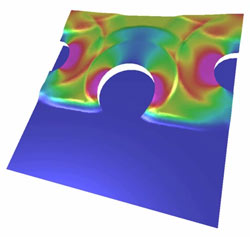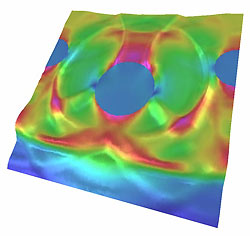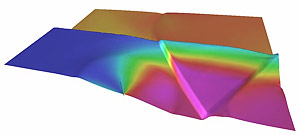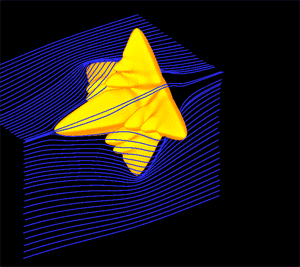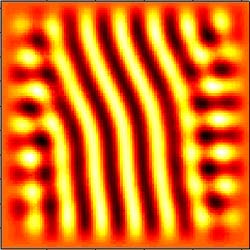Visualizations
Notes:
- The .mov files are the original formats.
- The Powerpoint files are single slides which contain the .mov file.
Simulation of Dynamic Particle Dewetting in Composite Material
Robert B. Haber, Mechanical Science and Engineering, University of Illinois at Urbana–Champaign
Research Assistants: Reza Abedi, Morgan Hawker,Mechanical Science and Engineering, University of Illinois at Urbana–Champaign
Research Scientist: Karel Matous, Center for Simulation of Advanced Rockets, University of Illinois at Urbana–Champaign
Elastodynamic simulation of particle dewetting: An adaptive spacetime discontinuous Galerkin model simulates shock–induced dewetting and rewetting of stiff inclusions. Height and color fields depict velocity magnitude and strain-energy density. Reflections, surface waves and focusing effects within the circular inclusions create a complex history of dewetting and rewetting. For details, see the research nugget on this topic.
Particle dewetting during wave propagation: .avi (197839 K), .mov (1576 K), .ppt (36 K)
Wave propagation through a fully-bonded particle model: .mov (2228 K), .ppt (34 K), .avi (176864 K)
Pixel-Exact Rendering of Spacetime Finite Element Solutions
Michael Garland, Computer Science, University of Illinois at Urbana–Champaign
Time steps from an elastodynamic problem showing crack-tip wave scattering within an elastic solid subjected to shock loading. Both velocity magnitude (height) and strain energy density (color) are shown. Each time step corresponds to a planar slic e through the spacetime mesh "Linear Elastodynamics" animation below. For details, see the research nugget on this topic.
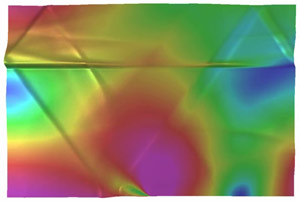
Wave propagation through middle crack tension specimen (fully bonded): .ppt (44 K), .avi (161552 K), .mov (3357 K)
Crack propagation in a middle crack tension specimen: .avi (138055 K), .mov (1738 K), .ppt (32 K)
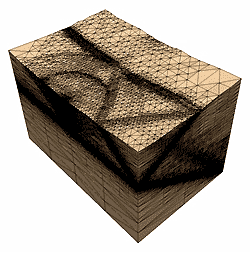
Adaptive Spacetime Meshing—Linear Elastodynamics
S. Chung2, Michael Garland2, Jeff Erickson2, Robert B. Haber1, John M. Sullivan4,
Research Assistants: Reza Adebi1, Yong Fan1, Shripad Thite2, Yuan Zhou2
Research Scientist: Damrong Guoy3
1- Mechanical Science and Engineering, 2- Computer Science, 3- Center for Simulation of Advanced Rockets , 4- Mathematics, University of Illinois at Urbana–Champaign
A rectangular plate with a crack is stressed on two opposite sides. The resulting shock wave travels through the plate and reflects off the crack tip. (Only the upper right quadrant of plate is simulated, with symmetric boundary conditions.) The spacet ime mesh computed by our algorithm, shown here with time as the vertical axis, accurately captures the passage of shear and pressure waves through the plate. For details, see the research nugget on this topic.
- 2D x Time mesh generation during wave propagation in middle crack tension specimen (crackSDG.ppt) (47 K)
- crackSDGmesh.avi (172832 K)
- crackSDGmesh.mov (7772 K)
Modeling Solidification Microstructures
Jonathan A. Dantzig, B. Athreya, A. Chang, Laxmikant Kale and Kai Wang, University of Illinois at Urbana-Champaign
A breakthrough simulation of directional solidification in a 3D flow field that was enabled by the parallel and adaptive capabilities of the FE framework and Charm++ (charm.cs.uiuc.edu).Simulation of directional solidication and design: .avi (142394 K), .avi (47471 K, smaller), .gif (3994 K, animated), .mov (7288 K), .ppt (43 K)
Modeling Solidification Microstructures
Jonathan A. Dantzig, Badrinarayan Athreya, Anthony Chang, Laximikant Kale and Kai Wang
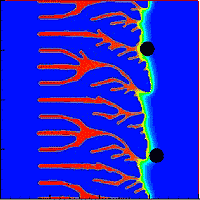
Phase Field Crystals
J. Dantzig, B. Athreya, A. Chang, L. Kale and K. Wang
